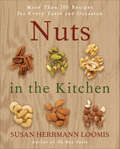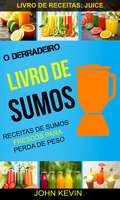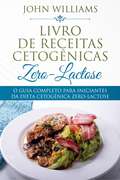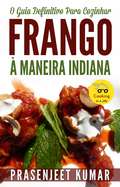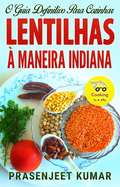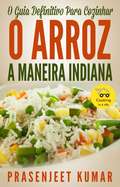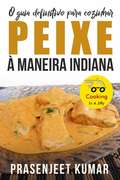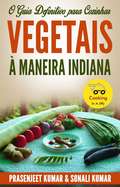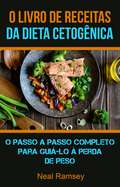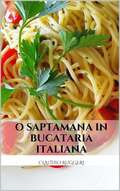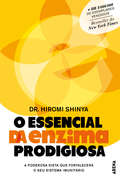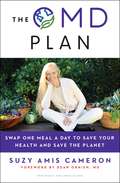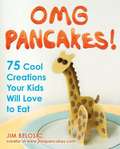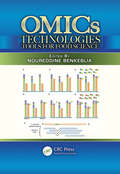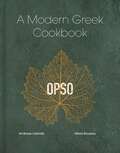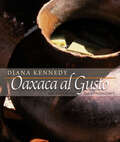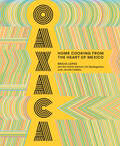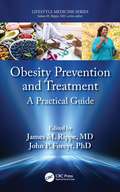- Table View
- List View
Nuts in the Kitchen: More Than 100 Recipes for Every Taste and Occasion
by Susan Herrmann LoomisRenowned cookbook author Susan Herrmann Loomis has traveled extensively to collect recipes that incorporate every kind of nut—from almonds to Brazil nuts, and everything in between. In these delectable recipes, you'll see nuts as much more than a tempting snack. Loomis shows how they complement, and can be the centerpiece of, every single meal of the day.Included in this imaginative collection are more than 100 easy-to-make recipes for small plates, salads, main courses, side dishes, and desserts. Start with breakfast and serve Waffles with Walnut Whipped Cream or Apricot and Pine Nut Compote. Share an evening with friends by serving Anise- and Fennel-Spiced Walnuts or Brazil Pesto with Pasta; next, move on to a main course of Gingered Fish on Spiced Macadamia Butter; and finish with refreshing Lemon Poppy Seed Ice Cream or Coconut Sticky Rice with Peanuts. Loomis provides an invaluable collection of The Basics—including recipes for Almond Milk, Lemony Hazelnut Butter, Poppy Seed Dressing, and Macadamia and Coconut Sprinkle—for stocking every pantry and adding a new dimension to daily meals.Along with the wonderfully diverse recipes in this book, you'll find nutritional information, menu ideas, and different kinds of food—simple, exciting, flavorful, unusual, easy, and good for you, too.Nuts in the Kitchen is the ultimate culinary guide for using these wonderful, healthful ingredients in inventive, sophisticated, and astonishing ways. Whether you are a vegetarian, a vegan, or a meat eater, you'll find yourself turning to this book over and over as you prepare meals large or small.
O Derradeiro Guia para a Caminhada: Como Planear com Sucesso uma Viagem de Mochila, um Acampamento, ou uma Caminhada
by John JohnsonEstá a pensar começar a fazer caminhadas? Gostaria de aprender a fazer caminhadas como um profissional? Se respondeu sim a estas perguntas então este livro é para si. Aprenda como começar e tudo o que precisa de saber sobre o desporto e como fazer uma caminhada como um profissional. Estas técnicas e dicas de acampamento vão ajudá-lo a começar e a caminhar melhor do que nunca! Introduzindo os segredos que os profissionais utilizam para escalar os terrenos mais difíceis! Com décadas de estratégias comprovadas, este ebook vai mostrar-lhe o caminho mais rápido e eficaz para aprender este desporto! O que está incluído: - Para Começar. - Listas. - Que Equipamento Usar. - Como Fazer uma Caminhada. - Preparação. E MUITO MAIS! Se quer ser mais forte e eficaz a fazer caminhadas, então este guia é para si. Aviso Legal: Este autor e ou o(s) proprietário(s) dos direitos autorais não fazem quaisquer reivindicações, promessas, ou garantias no que respeita à precisão, plenitude, ou adequação dos conteúdos deste livro, e renunciam expressamente à responsabilidade por qualquer erro e omissão nos conteúdos apresentados. Este produto serve apenas como referência. Por favor consulte um profissional antes de agir sobre qualquer conteúdo aqui expresso.
O Derradeiro Livro de Sumos: Juice)
by Nídia Rocha John KevinFazer sumos é a maneira mais fácil e rápida de transformar a sua vida. Receitas de sumos frescos, ricos em vitaminas e vegetais podem ajudá-lo a perder peso e melhorar a sua saúde ao acelerar o seu metabolismo e purificar todo o seu corpo. 25 Receitas de Sumo para a Perda de Peso é uma coleção de receitas de sumos frescos para aqueles que querem perder peso eficazmente sem prejudicar a sua saúde. É a companhia perfeita para quem está de dieta e quer perder mais uns centímetros e quilos, enquanto mantém o corpo nutrido, forte e saudável. Este livro tem informações sobre a confeção de sumos, a forma como lhe traz benefícios, e fantásticas receitas de sumos. Se deseja atrasar o envelhecimento precoce, manter-se saudável, melhorar o seu Sistema imunitário, e manter o seu sistema digestivo saudável, deve incorporar estes sumos na sua vida. A propriedade mais fantástica dos sumos, principalmente od sumos de vegetais e fruta, é que não sobrecarrega o seu sistema digestivo com a digestão das fibras; consequentemente, os nutrientes são absorvidos quase imediatamente após o consumo. Ao extrair os sucos naturais de uma grande variedade de frutos e vegetais, a confeção de sumos é uma excelente forma de o auxiliar a perder peso. Estes sumos naturais são baixos em calorias pois contém uma grande quantidade de água e fibras, que ajudam o corpo a eliminar toxinas. Estes sumos também contém ingredientes que diminuem o apetite. Por isso não se sentirá desconsolado ou com fome. "O Derradeiro Livro de Sumos: Receitas de Sumos Frescos para Perda de Peso" é o livro que necessita para a sua caminhada em direção a uma vida mais saudável e magra.
O Guia Completo Para Iniciantes da Dieta Cetogênica Zero-Lactose
by John WilliamsTem dificuldade para perder peso? Precisa de ajuda para regular os níveis de insulina? Você tem diabetes tipo II? Você tem hipertensão? Você quer perder a gordura visceral? Você sofre com refluxo ou inchaço? Então a dieta cetogênica pode ajudar a eliminar esses problemas. É uma das melhores e mais populares dietas no mundo por causa de sua efetividade em mudar a vida das pessoas, ajudando-as a perder peso e melhorar a saúde. Fazer uma dieta cetogênica pode ajudar: Remover dor abdominal Cólica Gases Inchaço Diarreia Limpa naturalmente a acne Reduz risco de câncer Reduz inflamação e mais. O Guia Completo Para Iniciantes da Dieta Cetogênica Zero-Lactose vai lhe ensinar: O que pode e o que não pode Receitas para café da manhã Lanches Acompanhamentos Pratos principais Sobremesas Compre sua cópia hoje e comece a perder peso!
O Guia Definitivo Para Cozinhar Frango À Maneira Indiana
by Prasenjeet Kumar51 maneiras de dar água na boca para cozinhar frango em um Instante, como somente os indianos podem. De Prasenjeet Kumar, o autor número 1 da série de livros de culinária “Cooking In A Jiffy”, vem o absolutamente melhor Guia para Cozinhar Frango com especiarias e sabores tão exóticos que você ficará pedindo mais. Você aprenderá a cozinhar frango com iogurte e leite de coco, mostarda e açafrão, folhas de curry e garam masala (literalmente especiarias picantes) e assim por diante. Portanto, esqueça seus nuggets de frango, asinhas, wraps e sanduíches de sabor semelhante. Diga também adeus às maneiras chatas de cozer, assar e enfornar pratos de frango e de ovos, e deixe este novo livro abrir seus olhos para as maravilhosas possibilidades de cozinhar frango da mesma maneira que fazem os indianos do norte, sul, leste e oeste. Existem 7 pratos para aperitivos (ou lanches), 8 receitas secas, 15 curries de frango, 5 receitas para cozinhar frango com arroz e 8 maneiras de cozinhar ovos À Maneira Indiana. Para as pessoas que não podem com especiarias ou que são guiadas pela nostalgia, existem 8 pratos dos dias do Raj britânico, usando queijo e envolvendo assar no forno, se você estivesse sentindo falta disso! E o ponto principal é que você, ao dominá-los, poderá lidar com qualquer prato indiano não vegetariano, o autor promete. Portanto, se você estava imaginando como incorporar esta excelente carne branca rica em proteínas, de baixa caloria e alta qualidade em sua dieta diária da maneira mais saborosa possível, basta pegar este livro com as duas mãos.
O Guia Definitivo Para Cozinhar Lentilhas À Maneira Indiana
by Prasenjeet Kumar Íris Bértolo58 maneiras das mais saborosas para cozinhar lentilhas enquanto sopas, caris, snacks, refeições completas e segure a respiração, sobremesas! Como só os indianos sabem. Do autor do best seller “Home Style Indian Cooking In a Jiffy” surge um tributo às lentilhas, da maneira como os indianos as cozinham. Então, diga adeus aos aborrecidos ensopados de lentilhas ou aos enjoativos feijões cozidos, e abra a sua mente para as maneiras desconcertantes que os indianos empregam para incluir as lentilhas em todas as suas refeições, quer seja como Dal (sopa), caril, snack ou mesmo sobremesa. “O Guia Definitivo Para Cozinhar Lentilhas à Maneira Indiana" permite-lhe saborear, neste contexto, até vinte das mais populares receitas caseiras de dal; dez caris; seis pratos de lentilhas cozinhadas com arroz; onze snacks; três kebabs; três parathas de lentilhas recheadas; e cinco sobremesas. Este poderá ser, simplesmente, o melhor livro de receitas de proteínas vegetais que poderá adquirir.
O Guia Definitivo Para Cozinhar O Arroz A Maneira Indiana
by Prasenjeet KumarDe uma cama para caril, a Pilaf, Biryani, Khitchi, Idli, Dosa, salgados e sobremesas, ninguém cozinha arroz com tanto amor quanto os índios De Prasenjeet Kumar, o best-seller na série de livros “Cooking In A Jiffy”, vem o melhor livro de receitas de arroz que qualquer pessoa que procura alimentos sem glúten deve agarrar com as duas mãos. Catalogando o lendário "caso de amor" que os índios têm com o arroz, o livro narra como o arroz faz parte intrínseca da vida de todo indiano, desde o nascimento até a morte. Neste contexto, o livro apresenta um total de 35 pratos de arroz de dar água na boca: oito receitas simples para panelas de arroz, cinco receitas para cozinhar arroz com lentilhas, cinco para cozinhar arroz com legumes e carnes, cinco maneiras de usar arroz em lanches e sete como sobremesas.
O Guia Definitivo Para Cozinhar Peixe À Maneira Indiana
by Prasenjeet Kumar Gilson Cardozo de Arruda43 maneiras de cozinhar peixe de dar água na boca em um INSTANTE como só os indianos sabem fazer. De Prasenjeet Kumar, o autor número 1 em best-sellers da série de livros de culinária “Cozinhando em um Instante”, lança o Guia Definitivo para Cozinhar Peixes com especiarias e sabores tão exóticos que você vai querer mais. Portanto, diga adeus às maneiras chatas e grelhadas de preparar pratos de peixe e camarão e deixe que este novo livro abra os olhos para as maravilhosas possibilidades de cozinhar os peixes do mesmo modo que os indianos do norte, do sul, do leste e do oeste. Há seis pratos para entrada (ou secos), 14 curres, 12 pratos de camarão e 4 maneiras de cozinhar a cabeça do peixe e as ovas (caviar) à moda indiana. Para os amantes de especiarias ou pessoas nostálgicas, há 7 pratos dos dias do Raj britânico. Então, se você está se perguntando como incorporar este soberbo, ensopado com longas cadeias de ácidos graxos ômega 3 poli-insaturados essenciais (que o corpo humano não pode produzir naturalmente), carne branca rica em proteínas de baixa caloria e uma elevada qualidade em sua dieta diária, basta agarrar este livro com as duas mãos.
O Guia Definitivo para Cozinhar Vegetais à Maneira Indiana
by Prasenjeet Kumar Íris Bértolo / iris.bertolo@gmail.comAs 101 maneiras mais saborosas para cozinhar vegetais para petiscos, sopas, caril, refeições completas e prenda a sua respiração, sobremesas! Como só os indianos sabem. Do autor da série Best seller de livros de receitas “Cooking In A Jiffy”, vem um tributo aos vegetais, cozinhados à maneira como os indianos os cozinham em suas casas. Portanto, esqueça as maneiras aborrecidas de cozinhar os pratos vegetarianos, cozidos e grelhados, e deixe que este novo livro lhe abra os horizontes para as maravilhosas possibilidades de cozinhar legumes à maneira como o fazem no norte, no sul, no oriente e no ocidente da Índia. “O Melhor Guia para Cozinhar Vegetais à Maneira Indiana” permite-lhe saborear, neste contexto, até 26 dos mais famosos caris caseiros, 24 receitas de pratos secos, 10 receitas para cozinhar legumes com arroz ou pães e 19 tipos de snacks e acompanhamentos. A maioria das receitas são de baixas calorias e com o uso opcional de malaguetas. Para os mais nostálgicos ou os que apreciam o desafio da comida picante, há 14 pratos dos tempos do Raj Britânico que utilizam queijo e envolvem cozedura, caso sintam essa falta! Finalmente, há 8 deliciosas sobremesas que os indianos adoram fazer com legumes. E o principal é que depois do leitor dominar estas receitas, garantimos que conseguirá confeccionar qualquer prato vegetariano indiano, de qualquer parte da Índia. Então, do que é que está à espera? Vá em frente e faça o download de um exemplar agora!
O Livro De Receitas Da Dieta Cetogênica: O Passo A Passo Completo Para Guiá-lo À Perda De Peso
by Neal RamseySe você quer obter os benefícios de uma dieta vegana e perder peso, sem abrir mão das apetitosas refeições, então preste muita atenção!!! Cada receita foi aperfeiçoada pelo distinto talento de Kyndra na escolha de ingredientes low-carb, integrais, frescos e acessíveis. Com o Keto Desejável, você poderá, sem esforço, criar pratos cremosos, rápidos e deliciosos daqueles que você demoraria horas para preparar. Liberte-se da rotina alimentar e abrace seu "mastercherf" interior enquanto você aprende sobre tudo: desde desde cozinhar o perfeito caldo low carb aos segredos da confeitaria cetogênica. Aqui está uma prévia do que está dentro do seu livro ... •Receitas de café da manhã cetogênico •Receitas cetogênicas do petisco •Cetogenic Meal Recipes •E muito mais...
O Livro de Receitas da Boa Vida da Cirurgia de Perda de Peso: Receitas para uma Alimentação Saudável e Feliz Após Sua Cirurgia Bariátrica
by Rosemary DolloffCozinhar é um dos muitos desafios após a cirurgia para perda de peso. Este livro de receitas, simples e claramente escrito ajuda você a manter o foco em sua dieta e em sua saúde, com 32 refeições saborosas e fáceis de preparar, e que toda a sua família pode desfrutar com você. As receitas são classificadas em café da manhã, almoço, jantar e lanches & aperitivos, para corresponder às dietas padrão pós-cirurgia. As porções são calculadas para totalizar 1 a 1-1 / 2 xícara, facilitando o respeito aos limites do plano alimentar recomendado pelo seu médico. As quantidades podem ser multiplicadas para alimentar um acompanhante ou toda a família. Cada receita inclui a composição nutricional, listando calorias, gorduras, carboidratos e proteínas. As refeições apresentam alto teor de proteína, mantendo baixos os teores de gordura, carboidratos e açúcar. A maioria das refeições é adequada para o estágio de alimentos sólidos da dieta, mas pode ser adaptada para o estágio de alimentos macios. As receitas saudáveis e deliciosas incluem: Quiche de Presunto e Queijo sem Crosta Vieiras Fritas e Abóbora de Verão (Amarela) Salada de Tortellini e Frango Hambúrgueres de Cordeiro com Queijo Feta Cogumelos Portobello Recheados Na seção Lanches e Aperitivos, a autora decodifica o conteúdo de açúcar e carboidratos dos shakes de proteína e barras de energia de marcas conhecidas, e recomenda os que têm o melhor sabor e a satisfazem, sem sabotar sua dieta. As receitas apresentam ingredientes frescos, facilmente encontrados no supermercado local, e de fácil limpeza depois. Mime-se com as excelentes comidas deste livro e desfrute de seu novo estilo saudável de vida !
O Melhor Livro de Receitas Ao Seu Gosto. Mais de 35 Receitas Rápidas E Deliciosas Ao seu Gosto
by Shelly CarterDescubra a melhor maneira de usufruir do programa Weight Watchers, com as receitas ao seu estilo, repletas de sabores suculentos e aromas irresistíveis! Quando se trata de escolher o plano de dieta certo para si, há muitas opções. Todos os planos oferecerem conselhos e sugestões sobre o que você é capaz de fazer para perder peso, mas muitos são pouco seguros, dão maus conselhos e são muito difíceis de seguir a longo prazo. Cada uma das receitas inclui um guia passo-a-passo para você seguir. Ele também fornece quantas porções pode servir, a preparação total, o tempo de cozedura, bem como o número de pontos para cada um dos pratos fornecidos para cada porção. Irá encontrar: Capítulo 1: O que é o Weight Watchers? Capítulo 2: Sistema de Pontos Capítulo 3: FAQs Capítulo 4: As regras do exercício físico Capítulo 5: Incorporar o exercício físico Capítulo 6: Receitas Não precisa de contar calorias, o que não é tão saudável quanto pensa, uma vez que ingerir 200 calorias de gelado não é tão nutritivo como ingerir 200 calorias de vegetais e carne. A chave do sucesso é uma dieta equilibrada com uma grande variedade de ingredientes saudáveis. Quando você escolhe e consome alimentos de baixa caloria e nutrientes, como vegetais, frutas e carnes magras, evita alimentos não saudáveis, processados, açucarados e ricos em gordura. Compre este livro e delicie os seus sentidos na deliciosa variedade de receitas que nele encontra.
O Saptamana In Bucataria Italiana
by Claudio Ruggeri M. LaviniaAm decis sa scriu aceasta carte de bucate dupa ce am luat notite ,timp de o saptamana ,din ceea ce mancasem ,toate acele feluri pe care mama le-a gatit pentru mine si sora mea .Sper sa pot da un sfat tuturor acelor persoane care, aud despre bucataria italiana si sunt curiosi ce anume mananca italienii zilnic .
O essencial da enzima prodigiosa
by Hiromi ShinyaMais de 3 000 000 de exemplares vendidos Bestseller do New York Times A poderosa dieta que fortalecerá o seu sistema imunitário Ganhe uma nova vida com a dieta do futuro! Através de conselhos práticos e muito fáceis de seguir, o Dr. Hiromi Shinya dá-nos a conhecer uma forma de vida saudável que facilita a produção corporal de uma enzima vital - a "enzima prodigiosa" - com extraordinárias capacidades regeneradoras e curativas. Qualquer pessoa, independentemente da predisposição genética, pode auxiliar o seu corpo de modo a evitar doenças cardíacas, obesidade, fibromas, obstipação, síndrome do cólon irritável, apneia do sono e doenças autoimunes. A chave está em entender o código da vida, o factor enzimático. O essencial da enzima prodigiosa revolucionará a sua forma de ver o corpo humano, a medicina e a saúde. O Dr. Hiromi Shinya ensina-lhe como conservar o abastecimento das enzimas prodigiosas e reverter processos degenerativos para fortalecer o sistema imunitário e as enzimas corporais e gozar de boa saúde.
OCR GCSE Food Preparation and Nutrition
by Val FehnersExam Board: OCRLevel: GCSESubject: Food Preparation & NutritionFirst Teaching: September 2016First Exam: June 2018Endorsed for OCR.Develop your students' knowledge and understanding of food and nutrition, improve their practical food preparation and cooking skills and prepare them for assessment with this book for the 2016 OCR Food Preparation and Nutrition GCSE.- Explains all food and nutrition concepts clearly, including simple definitions of key words- Helps students to apply their knowledge and understanding with engaging practical activities throughout, including photographs to illustrate all of the key techniques- Differentiates with stretch and challenge activities to ensure progression and to challenge more able learners- Prepares students for assessment with clear guidance on the Food Investigation and Food Preparation assessments, as well as advice and practice questions to help them prepare for the written exam
OCR GCSE Food Preparation and Nutrition
by Val FehnersExam Board: OCRLevel: GCSESubject: Food Preparation & NutritionFirst Teaching: September 2016First Exam: June 2018Endorsed for OCR.Develop your students' knowledge and understanding of food and nutrition, improve their practical food preparation and cooking skills and prepare them for assessment with this book for the 2016 OCR Food Preparation and Nutrition GCSE. - Explains all food and nutrition concepts clearly, including simple definitions of key words- Helps students to apply their knowledge and understanding with engaging practical activities throughout, including photographs to illustrate all of the key techniques- Differentiates with stretch and challenge activities to ensure progression and to challenge more able learners- Prepares students for assessment with clear guidance on the Food Investigation and Food Preparation assessments, as well as advice and practice questions to help them prepare for the written exam
OMD: The Simple, Plant-Based Program to Save Your Health, Save Your Waistline, and Save the Planet
by Dr Dean Ornish Suzy Amis CameronChange the World by Changing One Meal a Day Suzy Amis Cameron—environmental advocate, former actor, and mom of five—presents a clear-eyed and accessible guide for you to improve your health and shrink your personal carbon footprint simply by swapping one meat- and dairy-based meal for a plant-based one every day.The research is clear that a plant-based diet is the healthiest diet on Earth. But what many people don’t realize is that nothing else we do comes close to the environmental impact of what we eat. Now Suzy Amis Cameron explains how we can boost energy, feel better, live healthier, and heal the Earth, starting with just one meal a day. Developed at MUSE School, the school she founded with her sister Rebecca Amis, Suzy’s program makes it possible for anyone and everyone to reverse climate change while they embrace a healthier lifestyle. This one simple step will begin to help you lose weight and stay naturally thin, reverse chronic health concerns, improve overall wellbeing, enjoy newfound energy, and slash your carbon footprint in half. In OMD, Suzy shares her field-tested plan, outlining the latest science and research on why a plant-based diet is better for one’s health and the environment. Featuring fifty delicious, nourishing recipes and complete with inspiring success stories, shopping lists, meal plans, and pantry tips, OMD is an all-in-one resource for anyone who wants to take care of their body and our beautiful planet at the same time.
OMG Pancakes!
by Jim BelosicOver 75 recipes for crazy pancake concoctions... great for any occasion from holidays to everyday Sundays! When Jim Belosic started making pancakes in unusual designs, he was just trying to earn some cool cred with his daughter, Allie. Little did he know how happy he'd make her-and the millions of fans who eagerly await his latest creations on the Internet.Pancake unicorns, beehives, and even bridges, Ferris wheels, and construction cranes have all risen to life through Jim's artful use of squeeze bottles, tasty and nutritious coloring and flavor techniques, and fearless creativity. OMG Pancakes also includes holiday-themed creations like Ghost and Pumpkin for Halloween, Turkey for Thanksgiving, a Christmas Tree, and much more.Now-with a little help from Jim-everyone can turn breakfast into art. Filled with four-color photos, and step-by- step instructions, OMG Pancakes! will be devoured by families and crafty foodies alike.
OMICs Technologies: Tools for Food Science
by Noureddine BenkebliaSince the completion of the Human Genome Project, food and nutrition sciences have undergone a fundamental molecular transformation. New discoveries in molecular biology, analytical chemistry, and biochemistry have led to the development of new tools that are likely to revolutionize the study of food. OMICS Technologies: Tools for Food Science expl
ONE: One Pan, One Hob, One Meal
by Elena SilcockFrom the pan to the table in no time at all.Included are 85 easy, budget-friendly recipes to suit busy lifestyles and those with limited kitchen space. All the delicious dishes can be made in one of two pans - either a large saucepan or a non-stick frying pan - and require little to no skill, as directions are just for cooking over a high, medium or low heat. All the recipes can be cooked on a gas, electric or induction hob and you will get the same incredible results every time. Featuring easy cheats and supermarket ingredients, these are handy recipes to cook every night of the week. From light and speedy dishes including Just-add-water beef pho and Vodka risotto with fresh tomatoes, to indulgent and comforting meals like Sausage and broccoli gnocchi and Sweet potato, kale and cashew nut curry, alongside speedy sweet treats such as Chocolate-centre French toast and Baby doughnuts, there are plenty of surprising, nourishing options that the whole family can enjoy together.
OPSO: A Modern Greek Cookbook
by Nikos Roussos Andreas LabridisInspired by Nikos and Andreas' Greek culinary heritage and their love of fresh ingredients, OPSO restaurant opened in the heart of Marylebone in 2014 with a mission to elevate modern Greek food and introduce Londoners to fine Greek dining.With over 80 recipes, including all of OPSO's signature Greek dishes, seasonal specials and Greek kitchen favourites from their OPSO at Home menu, there are delicious Modern Greek recipes for every meal and occasion.Opening with the Greek Larder, celebrating small plates and Greece's famous sharing food culture and generous hospitality, there are chapters on Salads, Vegetable dishes, Meat Feasts, Seafood (raw, cured and to share), Barbecues including Souvlakia, Brunches, Breads, Pastries, Deserts and Sweet Treats. Including simple but delicious recipes for Spanakopita with lemon yoghurt dip, to Baby beetroot salad with Skordalia and blackberries to elevated restaurant favourites Lamb shank with mushrooms trahanas, their signature marinated and slow roasted Octopus stifado and a unique and delicious Greek take on Coffee tiramisu profiteroles!With stunning photography from the restaurant, showcasing the finest fresh ingredients and beautifully modern food styling, this will be a well used and loved addition to all cooks' bookshelves.
Oaxaca al Gusto: An Infinite Gastronomy (The William and Bettye Nowlin Series in Art, History, and Culture of the Western Hemisphere)
by Diana KennedyNo one has done more to introduce the world to the authentic, flavorful cuisines of Mexico than Diana Kennedy. Acclaimed as the Julia Child of Mexican cooking, Kennedy has been an intrepid, indefatigable student of Mexican foodways for more than fifty years and has published several classic books on the subject, including The Cuisines of Mexico (now available in The Essential Cuisines of Mexico, a compilation of her first three books), The Art of Mexican Cooking, My Mexico, and From My Mexican Kitchen. Her uncompromising insistence on using the proper local ingredients and preparation techniques has taught generations of cooks how to prepare-and savor-the delicious, subtle, and varied tastes of Mexico. In Oaxaca al Gusto, Kennedy takes us on an amazing journey into one of the most outstanding and colorful cuisines in the world. The state of Oaxaca is one of the most diverse in Mexico, with many different cultural and linguistic groups, often living in areas difficult to access. Each group has its own distinctive cuisine, and Diana Kennedy has spent many years traveling the length and breadth of Oaxaca to record in words and photographs "these little-known foods, both wild and cultivated, the way they were prepared, and the part they play in the daily or festive life of the communities I visited. " Oaxaca al Gusto is the fruit of these labors-and the culmination of Diana Kennedy's life's work. Organized by regions, Oaxaca al Gusto presents some three hundred recipes-most from home cooks-for traditional Oaxacan dishes. Kennedy accompanies each recipe with fascinating notes about the ingredients, cooking techniques, and the food's place in family and communal life. Lovely color photographs illustrate the food and its preparation. A special feature of the book is a chapter devoted to the three pillars of the Oaxacan regional cuisines-chocolate, corn, and chiles. Notes to the cook, a glossary, a bibliography, and an index complete the volume. An irreplaceable record of the infinite world of Oaxacan gastronomy, Oaxaca al Gusto belongs on the shelf of everyone who treasures the world's traditional regional cuisines.
Oaxaca al Gusto: An Infinite Gastronomy (The William and Bettye Nowlin Series in Art, History, and Culture of the Western Hemisphere)
by Diana KennedyA James Beard Foundation Award–winning record of the traditional regional cuisines of Oaxaca, from one of the world&’s foremost authorities on Mexican cooking.No one has done more to introduce the world to the authentic, flavorful cuisines of Mexico than Diana Kennedy. Acclaimed as the Julia Child of Mexican cooking, Kennedy has been an intrepid, indefatigable student of Mexican foodways for more than fifty years and has published several classic books on the subject, including The Cuisines of Mexico (now available in The Essential Cuisines of Mexico, a compilation of her first three books), The Art of Mexican Cooking, My Mexico, and From My Mexican Kitchen. Her uncompromising insistence on using the proper local ingredients and preparation techniques has taught generations of cooks how to prepare—and savor—the delicious, subtle, and varied tastes of Mexico.In Oaxaca al Gusto, Kennedy takes us on an amazing journey into one of the most outstanding and colorful cuisines in the world. The state of Oaxaca is one of the most diverse in Mexico, with many different cultural and linguistic groups, often living in areas difficult to access. Each group has its own distinctive cuisine, and Diana Kennedy has spent many years traveling the length and breadth of Oaxaca to record in words and photographs &“these little-known foods, both wild and cultivated, the way they were prepared, and the part they play in the daily or festive life of the communities I visited.&” Oaxaca al Gusto is the fruit of these labors—and the culmination of Diana Kennedy&’s life&’s work. Organized by regions, Oaxaca al Gusto presents some three hundred recipes—most from home cooks—for traditional Oaxacan dishes. Kennedy accompanies each recipe with fascinating notes about the ingredients, cooking techniques, and the food&’s place in family and communal life. Lovely color photographs illustrate the food and its preparation. A special feature of the book is a chapter devoted to the three pillars of the Oaxacan regional cuisines—chocolate, corn, and chiles. Notes to the cook, a glossary, a bibliography, and an index complete the volume.
Oaxaca: Home Cooking from the Heart of Mexico
by Bricia Lopez Javier CabralA colorful celebration of Mexican cuisine from LA’s landmark Oaxacan restaurant—with recipes for moles, salsa, cocktails, family meals and more.Oaxaca is the culinary heart of Mexico, and since opening its doors in 1994, Guelaguetza has been the center of life for the Oaxacan community in Los Angeles. Founded by the Lopez family, Guelaguetza has been offering traditional Oaxacan food for twenty-five years. In this delightful introduction to Oaxacan cuisine, each dish articulates the Lopez family story, from Oaxaca to the streets of Los Angeles and beyond. Showcasing the “soul food” of Mexico, Oaxaca offers 140 authentic, yet accessible recipes using some of the purest pre-Hispanic and indigenous ingredients available. From their signature pink horchata to the formula for the Lopez’s award-winning mole negro, Oaxaca demystifies this essential cuisine.
Obesity Prevention and Treatment: A Practical Guide (Lifestyle Medicine)
by James M. Rippe John P. ForeytThe World Health Organization estimates that there are 2.1 billion individuals with obesity globally. Nearly three quarters of adults in the United States are overweight or obese. The average individual with obesity cuts ten years off their life expectancy, yet less than 40% of physicians routinely counsel individuals concerning the adverse health consequences of obesity. Obesity Prevention and Treatment: A Practical Guide equips healthcare practitioners to include effective weight management counselling in the daily practice of medicine. Written by lifestyle medicine pioneer and cardiologist, Dr. James Rippe and obesity expert Dr. John Foreyt, this book provides evidence-based discussions of obesity and its metabolic consequences. A volume in the Lifestyle Medicine Series, it provides evidence-based information about the prevention and treatment of obesity through lifestyle measures, such as regular physical activity and sound nutrition, as well as the use of new medications or bariatric surgery available to assist in weight management. Provides a framework and practical strategies to assist practitioners in safe and effective treatments of obesity. Contains information explaining the relationship between obesity and increased risk of heart disease, diabetes, cancer, osteoarthritis, and other chronic conditions. Chapters begin with bulleted key points and conclude with a list of Clinical Applications. Written for practitioners at all levels, this user-friendly, evidence-based book on obesity prevention and treatment will be valuable to practitioners in general medicine or subspecialty practices.
